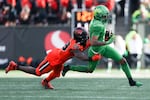
Oregon wide receiver Troy Franklin, right, is brought down by Oregon State defensive back Kitan Oladapo during their football game on Nov 26, 2022, in Corvallis, Ore. The Ducks and Beavers are likely to keep playing annual games, even as they compete in different athletic conferences starting in 2024.
Amanda Loman / AP
Shake-ups in athletic conferences will seriously change the landscape at University of Oregon and Oregon State University from the experience of student-athletes, their families and fans to the finances and relationships of the institutions themselves. Conference changes are official next year, but their effects are already being felt on campuses across the country.
As UO begins its final season in the Pac-12 conference before moving onto the Big Ten, OSU is considering next steps as one of just two schools left in the conference that once included the largest universities on the West Coast. But a number of questions remain unanswered moving forward.
What led to this?
The Pac-12 Conference, and its previous iterations, has existed for more than 100 years. Both University of Oregon and Oregon State University were part of the original membership of the conference in 1915, first known as the Pacific Coast Conference.
University of Oregon announced its move from the Pac-12 to the Big Ten last month, following major instability within the Pac-12, according to reporting from the Associated Press. That included an underwhelming media deal from the conference and other teams’ decisions to leave.
The move to the Big Ten means more money for UO, according to the AP. It also means “stability and exposure,” UO’s athletic director Rob Mullens said in a statement at the time.
Both the University of Southern California and the University of California, Los Angeles, decided last year to leave the Pac-12 and join the Big Ten. University of Washington made the decision to move to the Big Ten at the same time UO did. All of those new additions will join the conference in the fall of 2024.
Over the last two months, Colorado, Arizona, Arizona State and Utah all also announced their decision to leave the Pac-12 for the Big 12 conference, according to the AP.
Those moves left just four schools in the Pac-12: Oregon State University, Washington State University, Stanford University and University of California, Berkeley.
Stanford and Cal announced that they would leave the Pac-12 for the Atlantic Coast Conference Friday morning, further dismantling the historic West Coast league.

Students walk across Oregon State University's Corvallis campus in this Oct. 27, 2017, file photo.
Bryan M. Vance / OPB
What does this mean for OSU?
While UO gets a deal that likely means more money and more national exposure, OSU is left to pick up the pieces of the Pac-12.
At a press conference Friday, OSU President Jayathi Murthy was asked if there were any regrets about not finding a solution earlier, before the Pac-12 was brought down to just two schools. She said Oregon State has been working hard to find the best path forward, but it didn’t have as many options as other universities in the first place.
“Our options are centrally tied to being in a small town and not being able to deliver the TV audiences that these big media contracts require, and that’s a fact of our geographic location. It’s not easily changed,” Murthy said. “There aren’t easy options for us to simply hop from conference to conference, even if we were willing to simply blow the Pac-12 up, which I’ve never been willing to do.”
Murthy acknowledged that money and media deals is a big part of why these major conference realignments are happening, and why OSU is in the position it is.
“I’m sorry that a top 20 football team ends up where we are because of the focus on media rights and media evaluations,” she said.
Both Murthy and OSU Athletic Director Scott Barnes said the news of Stanford and Cal leaving was not surprising.
At an OSU Board of Trustees meeting last week, Barnes said the university was focusing its energy toward solutions.
He mentioned five guiding principles the university is focused on as it contemplates the path ahead:
- Prioritizing student-athletes, both in their academic and athletic goals
- Ensuring that OSU student-athletes can continue to compete at the highest level possible
- Continuing to provide the best experience for OSU alumni and sports fans
- Creating visibility for OSU both on a national and global level
- Maximizing financial resources both for OSU sports programs and support for student-athletes
Murthy said during Friday’s press conference that an announcement will come sometime in the near future, in “weeks rather than months,” about OSU’s next move — whether it be efforts toward rebuilding the Pac-12 or joining a new conference.
How likely is it that the Pac-12 can rebuild?
With Stanford and Cal leaving for the ACC, OSU’s initial goal of rebuilding the Pac-12 seems further away than ever.
“It is possible, but there’s no question that it’s much more complicated,” Murthy said Friday. “... Jumping from the conference was never the first option. Making the conference work was always where my heart and my mind lay.”
Murthy and Barnes said rebuilding the Pac-12 is not entirely off the table, but there are a lot of simultaneous conversations happening, including conversations about joining another conference, like the nearby Mountain West.
“We’re one of the charter members of the Pac-12, and so we’re deeply connected to it, aware of its reputation and its reach, which is why we keep saying that it’s so important to consider it as one of the directions we should take seriously,” Murthy said. “But, absolutely, we’ve been having great conversations with a number of conferences and looking at the various forms in which we can connect with them.”
What changes will student-athletes see?
Student-athletes at OSU and UO make up a relatively small percentage of the total student body.
At OSU last year, there were more than 500 student-athletes — roughly 1.5% of total students. UO also has more than 500 student-athletes. That’s about 2% of the university’s total student body.
Still, conference realignment means big changes for those students.
While the current formation of the Pac-12 is made up of universities from the western region of the country, University of Oregon’s new conference — the Big Ten — will be made up of schools primarily from the Midwest and Northeast.
That means current UO student-athletes will be playing vastly different teams than they’re used to next year. Instead of playing teams based in Washington or Arizona, UO student-athletes will have to travel across the country to play games in such places as New Jersey and Michigan.
Jimmy Stanton, UO’s senior associate athletics director for communications, said the university is still working with the Big Ten to figure out scheduling logistics for the 2024-25 school year.
Extra travel won’t make a huge difference for UO’s football team, which typically only plays one game per week and travels using a private plane.
It will however make a difference for sports that play more frequently and that travel using commercial flights.
That’s something student-athletes at OSU are thinking about as the future of the Pac-12 hangs in the balance.
Tyler Bilodeau, a basketball player at OSU, told OPB’s “Think Out Loud” that if OSU were to join another conference, or schools from other parts of the country were to join the Pac-12, it would not be too hard for his team to travel, but that’s not the case for other sports.
“We only play two games a week,” Bilodeau said. “I think it wouldn’t be too bad for basketball, but I know for sports like baseball, they play a lot of games a week, so that would probably be pretty hard on them.”
What conference a college belongs to can have a big influence on where student-athletes end up going to school. That was the case for Bilodeau.
“I wanted to play in a Power Five conference, and I grew up watching the Pac-12, being from the West Coast, so it was definitely one of the big reasons why I wanted to come here,” he said.
But Bilodeau said had he known about the conference realignments ahead of time, he still would’ve chosen OSU.
“I believe in our coaches and our staff to do what’s right, to do what’s best for the school,” he said.

FILE: The Oregon Marching Band displays a giant United States flag on the field at Autzen Stadium before a football game against Colorado, Oct. 11, 2019, in Eugene, Ore.
Chris Pietsch / AP
What are the financial implications of conference realignment?
While it can be assumed that UO will end up making more money as part of the Big Ten than they would have with the Pac-12 and that OSU may lose money in whatever situation they end up in next year, not much more can be said than that at this point.
“We need to absolutely face the reality that the revenues that we will be receiving will be less,” Barnes said at the Friday press conference. “So our priority in that is what it’s always been, and that’s to retain a very high-level, vibrant, holistic experience for our student-athletes.”
During OSU’s last board meeting, Barnes laid out the financials for the university’s current year in the Pac-12.
In the upcoming fiscal year, OSU expects to see roughly $95 million for athletics — coming from projected Pac-12 and NCAA revenues, ticket sales and other sports-related revenues.
The university is expected to make nearly $27 million alone from the last year of the Pac-12′s media rights deal this upcoming season.
“As we continue a path forward, we know that revenues will be less. How much less? Not certain yet,” Barnes said Friday.
Not much has been made public about UO’s new deal with the Big Ten, which won’t start until next summer. According to reporting from the Associated Press, UO and University of Washington could receive about $30 million per year to start, with annual increases.
Stanton with UO told OPB that Big Ten revenue is still to be determined.
“Annual conference distributions are based on a variety of components, including media rights agreements, which will be higher than the Pac-12 media rights distributions for this year,” Stanton said.
